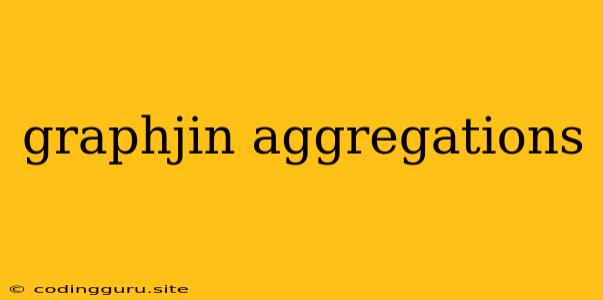Unlocking the Power of GraphJin Aggregations
Have you ever felt limited by the query capabilities of your traditional databases when working with complex data relationships? Enter GraphJin aggregations, a powerful feature that empowers you to delve deeper into your data and uncover valuable insights, all while simplifying your data processing.
What are GraphJin aggregations?
At its core, GraphJin is a GraphQL engine designed for seamless integration with PostgreSQL databases. It brings the flexibility of GraphQL to the structured world of relational databases, enabling you to query your data in a highly intuitive and expressive way. GraphJin aggregations, then, are a powerful tool within this framework, allowing you to perform aggregate functions on your data. Think of them as the "superpower" that enhances your ability to analyze and understand your data.
Why are aggregations so important?
Imagine you're running an e-commerce store. You'd likely want to understand:
- Average order value: What's the typical amount customers spend per order?
- Total sales by month: How much revenue are you generating each month?
- Top selling products: Which items are generating the most revenue?
These questions all rely on the power of aggregations. They allow you to summarize, group, and quantify your data in meaningful ways. GraphJin aggregations, with their simple syntax and integration with GraphQL, make this process incredibly easy and efficient.
How do GraphJin aggregations work?
GraphJin aggregations operate by leveraging the power of PostgreSQL's aggregate functions. They allow you to perform operations like:
- COUNT: Count the number of records in a dataset.
- SUM: Calculate the sum of values in a column.
- AVG: Find the average value in a column.
- MAX: Determine the maximum value in a column.
- MIN: Determine the minimum value in a column.
These powerful functions, combined with the flexible nature of GraphQL, provide a potent tool for data analysis.
Let's see an example:
Imagine you have a table called "orders" with columns for "order_id", "customer_id", and "amount". You want to find the average amount spent by each customer.
query {
customers {
id
orders {
amount
}
averageOrderAmount: aggregate(orders: { _avg: { amount: true } })
}
}
This query uses the aggregate directive with the _avg function to calculate the average order amount for each customer.
Benefits of using GraphJin aggregations:
- Simplified Querying: The intuitive GraphQL syntax makes writing complex aggregations effortless.
- Increased Efficiency: GraphJin leverages PostgreSQL's optimized aggregate functions for fast data processing.
- Enhanced Data Insights: Extract meaningful insights from your data with ease, allowing you to make informed decisions.
- Improved Data Visualization: The aggregated data can be easily used to create informative dashboards and visualizations.
- Flexible Filtering: You can filter and group your data using the power of GraphQL, giving you granular control over your analysis.
Conclusion
GraphJin aggregations represent a powerful tool for any data-driven application. By leveraging the power of GraphQL and PostgreSQL's aggregate functions, you can effortlessly analyze, summarize, and understand your data. Whether you're building an e-commerce platform, a data analytics dashboard, or any other data-intensive application, GraphJin aggregations can significantly streamline your data processing and empower you to extract valuable insights.
